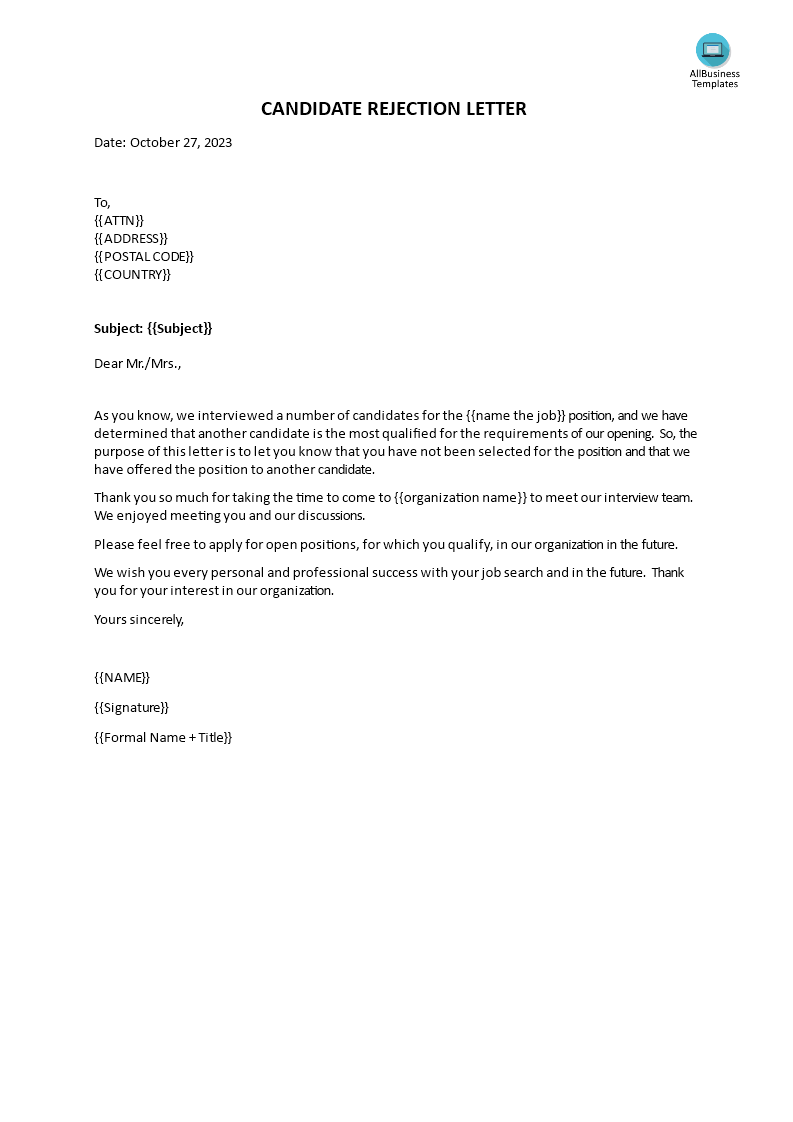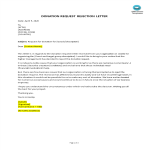Candidate Rejection Letter Email
Save, fill-In The Blanks, Print, Done!

Download Candidate Rejection Letter Email
Microsoft Word (.docx)Or select the format you want and we convert it for you for free:
- This Document Has Been Certified by a Professional
- 100% customizable
- This is a digital download (24.95 kB)
- Language: English
- We recommend downloading this file onto your computer.
How to create a candidate rejection letter email? How do rejection letters work? We have provided a sample template of a rejection letter that you may use as a guide when writing your own letter. This letter should be professional and courteous, and provide a clear reason for the rejection. An easy way to start completing your document is to download this example candidate rejection letter template now!
A candidate rejection letter, also known as a rejection email or rejection letter, is a formal communication sent by an employer or hiring manager to inform a job applicant that they have not been selected for a particular job position. It is a courteous and professional way to close the communication loop with candidates who were not chosen to move forward in the hiring process.
Here are the key components typically included in a candidate rejection letter:
- Contact Information: Include the candidate's name and address (if sending a physical letter) and your own contact information.
- Salutation: Address the candidate by name if possible. If you don't have the candidate's name, use a general salutation such as "Dear Applicant" or "Dear Candidate."
- Opening Statement: Begin the letter by expressing appreciation for the candidate's interest in the position and for taking the time to apply.
- Notification of Decision: Clearly and directly communicate that the candidate has not been selected for the job. You may use phrases like:
- "I regret to inform you that we have selected another candidate for the position."
- "After careful consideration, we have chosen a different candidate for the role."
- Feedback (Optional): Some rejection letters may include constructive feedback to help the candidate understand why they were not selected. While this is not always provided, it can be helpful for candidates to know how to improve their future job applications.
- Encouragement: Offer words of encouragement, such as thanking the candidate for their interest and encouraging them to apply for future positions within the company if applicable.
- Closing Remarks: End the letter with a polite and positive note, such as wishing the candidate success in their job search or future endeavors.
- Complimentary Close: Use a courteous closing, such as "Sincerely," "Best regards," or "Yours faithfully."
- Signature: Sign the letter with your name if it's a hard copy, or include your typed name if sending electronically.
- Contact Information: Include your contact information (email and phone number) in case the candidate has questions or would like to seek further clarification.
It's important to maintain a respectful and professional tone throughout the rejection letter, as the goal is to leave the candidate with a positive impression of your organization. Even in rejection, you want to uphold the company's reputation and potentially keep the door open for future interactions.
Download this candidate rejection letter template now for your own benefit!
DISCLAIMER
Nothing on this site shall be considered legal advice and no attorney-client relationship is established.
Leave a Reply. If you have any questions or remarks, feel free to post them below.
Related templates
Latest templates
Latest topics
- Hourly Weekly Schedule Template
How do I make an hourly schedule? Streamline your daily planning with our versatile hourly daily weekly schedule templates - Excel Templates
Where do I find templates for Excel? How do I create a template in Excel? Check these editable and printable Excel Templates and download them directly! - GDPR Compliance Templates
What do you need to become GDPR compliant? Are you looking for useful GDPR document templates to make you compliant? All these compliance documents will be available to download instantly... - Daily Report Sheets For Preschool
How do you create a kindergarten schedule or write a daily report for a preschool? Check out these preschool templates here. - Celcius To Farenheit Chart
How to Download our temperature Celsius to Fahrenheit conversion charts and streamline your temperature calculations and conversions here.
cheese


